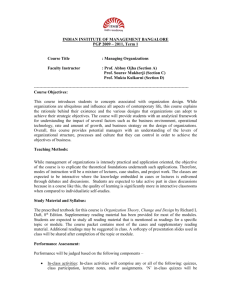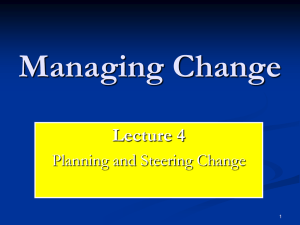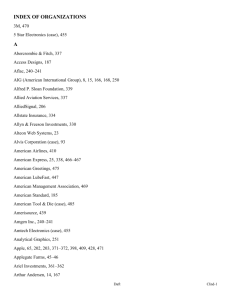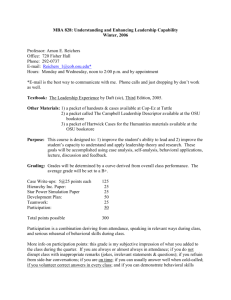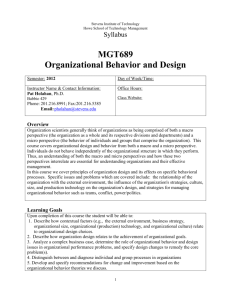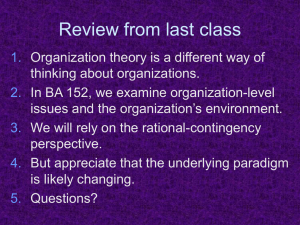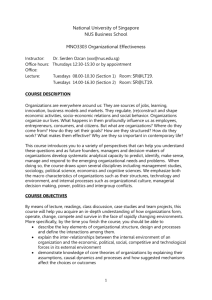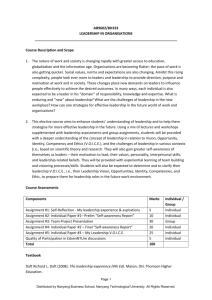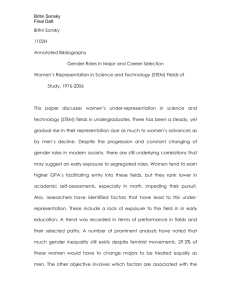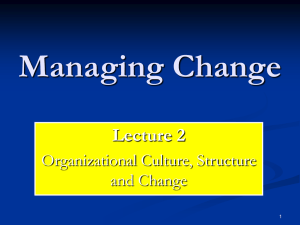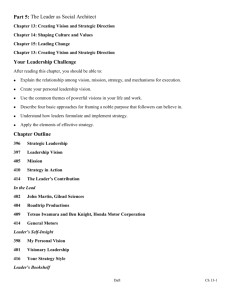Managers and Managing Class #1
advertisement
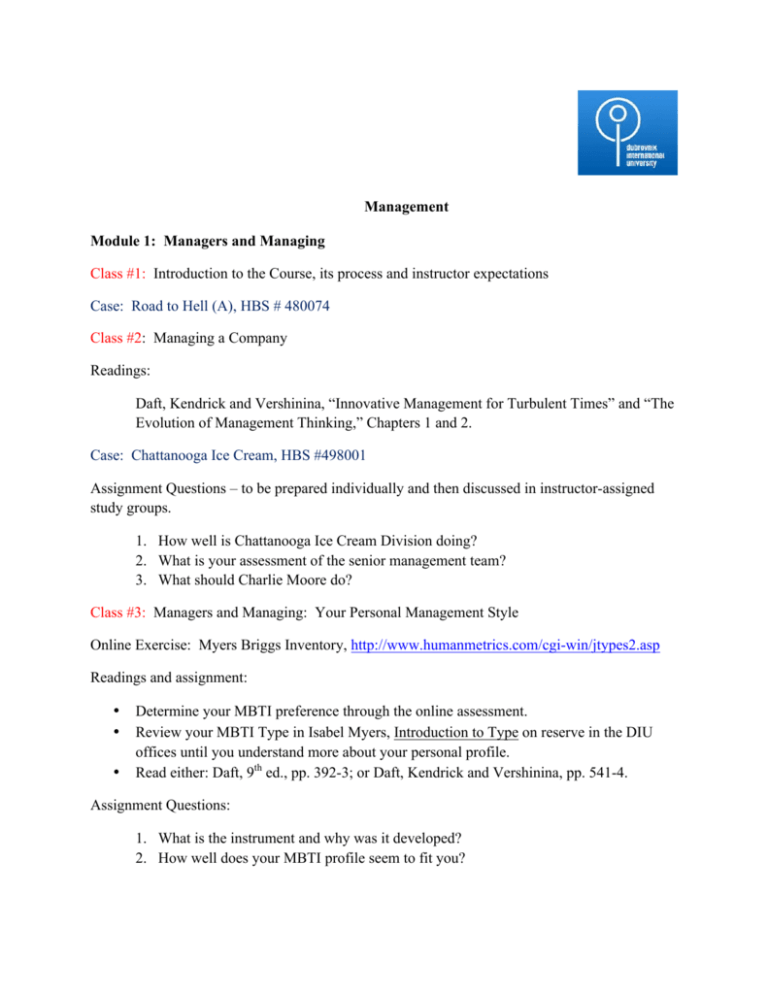
Management Module 1: Managers and Managing Class #1: Introduction to the Course, its process and instructor expectations Case: Road to Hell (A), HBS # 480074 Class #2: Managing a Company Readings: Daft, Kendrick and Vershinina, “Innovative Management for Turbulent Times” and “The Evolution of Management Thinking,” Chapters 1 and 2. Case: Chattanooga Ice Cream, HBS #498001 Assignment Questions – to be prepared individually and then discussed in instructor-assigned study groups. 1. How well is Chattanooga Ice Cream Division doing? 2. What is your assessment of the senior management team? 3. What should Charlie Moore do? Class #3: Managers and Managing: Your Personal Management Style Online Exercise: Myers Briggs Inventory, http://www.humanmetrics.com/cgi-win/jtypes2.asp Readings and assignment: • • • Determine your MBTI preference through the online assessment. Review your MBTI Type in Isabel Myers, Introduction to Type on reserve in the DIU offices until you understand more about your personal profile. Read either: Daft, 9th ed., pp. 392-3; or Daft, Kendrick and Vershinina, pp. 541-4. Assignment Questions: 1. What is the instrument and why was it developed? 2. How well does your MBTI profile seem to fit you? 3. Is this useful for managers and companies? What data does it provide individual managers? Companies? Class 4: Leadership vs. Management Readings: Daft, Kendrick and Vershinina, chapter 15; or Daft, 5th ed., chapter 16; or Daft 9th ed., chapter 14. William Ellet, The Case Study Handbook. (Boston: Harvard Business School Press, 2007), chapter 3, pp. 19 – 36. Assignment: Go online to take a leadership quiz. http://psychology.about.com/library/quiz/blleadershipquiz.htm Homework assignment: Write a one or two page statement for your personal journal answering the following questions. 1. Does the leadership profile fit your own self-image? 2. What do your MBTI type and your leadership profile tell you about yourself? Can they help you think about the kind of organization or career which would best suit you? Study Group and Class Assignment questions: 1. What is the difference between a manager and a leader? 2. In your study groups, agree on a list of two or three examples of both a leader and a manager. Come to class prepared to discuss and defend your choices. Class #5 and 6: Different Styles in the same company: Can both be effective Cases: Nerve Wire, HBS # 402022 Kirk Arnold, HBS #402020 Malcolm Frank, HBS #402021 Assignment questions: 1. What are the challenges NerveWire is facing at this stage in its history? 2. In what ways is Kirk effective? What could she do better? Is her style suited to the current situation at NerveWire? 3. In what ways is Malcolm effective? What could he do better? Is his style suited to the current situation at NerveWire? There will be 50-minute in class video of two Nerve Wire managers. Module 2: Planning: Using Management Planning Tools: Mission Statements, SWOT analysis, Strategic 5 Forces Analysis Readings for the week: Class # 7: Read Daft, Kendrick and Vershinina, chapters 7. Classes #8 and 9: Read Daft, Kendrick and Vershinina, chapter 8. Class #7: Organizational Planning and Goal Setting: Missions Assignment: In your new study groups, find their stated Missions for your two organizations. In some cases, the Mission will not be stated explicitly. In those cases, you will have to deduce the Mission from reading their website or talking to other people about the organization. In your study groups discuss the following questions and come to class prepared to lead a discussion of your organizations’ missions. 1. What do their mission statements tell you about the organizations? How do the missions differ in these two organizations? 2. Are they motivating? What behaviors are they motivating? 3. How are their Mission statements related to their product, industry or strategy? How can two organizations in the same industry have such different missions? 4. Which of the two organizations has the most effective Mission statement? Why? Class #8: Organizational Planning and Goal Setting: SWOT Analysis Reading: Daft, 9th ed., pp.286-7. (Check the index in the other Daft editions for the section on SWOT.) Assignment: Perform a SWOT analysis of your two organizations. Read the handout given to you in the previous class and complete the template of a SWOT analysis for your two organizations. Class #9: Strategy: Industry and the Competitive Environment Assignment: Review Porter’s Five Competitive Forces from Daft, 5th ed., chapter 8. In your study groups, do a 5-forces analysis of your industries: Come to class prepared to present your industry. 1. Is it a good or a bad industry to compete in? 2. If it is a “bad” industry, how would you compete if your company were in that industry? Class #10: Strategic Analysis Case: Swatch and the Global Watch Industry Video: in class on Swatch Assignment Questions: In your study groups, prepare the following questions to analyze the Swatch case: 1. In what ways is the watch industry global? Why did the industry begin in Switzerland? 2. Why did Timex succeed the Swiss as the world volume leader in the 1950’s – 60’s? Why then did Seiko success Timex? 3. How did Swatch manage to resuscitate the Swiss watch industry? 4. What specific course of action to you recommend to Hayek? What is next for the watch industry? Module 3: Organizing Class # 11: Structure Text: Chapter on Structure: Dalt, et al. Chapter 10. Lecture. Handouts in class for exercises to solve structural problems. Class # 12: Structured Communication: The Impact of Organization Structure on Behavior How structure impacts communication in teams. In class exercise in teams of 5 or 6. Module 4: Leading Class #13: Human Resource Management: Managing Mentor – Mentee relationships Case: Role Plays—Mini-case Simulations—Interpersonal Relations (Darden Business Publishing case # UV0831) Case: Taxi! Role Play (Three Darden Business Publishing cases # UV0866) Lecture on HRM Class#14: HRM Voice in the Workplace Case: The Treadway Tire Company: Job Dissatisfaction and High Turnover at the Lima Time Plant, HBS case# 2190 In your study groups, prepare the following questions: 1. What is the relationship between line foremen at Treadway’s Lima plant and other groups within the plant: general supervisors and area managers, top management, the union, hourly workers, each other? 2. How do foremen feel about their jobs and why? 3. What are the consequences of those feelings? 4. What should Ashley Wall recommend? Class #15: Entrepreneurship – Managing Small Business Start - ups Text: Managing Small Business Start – ups (Daft, 9th ed., Chapter 6.) Entrepreneurship game (in teams) - http://www.entre-ed.org/index.html Module 5 : Controlling -- Analyzing a Firm’s Performance Class #16: Financial statements and ratios – Lecture and Handouts for students Class #17: Stock exchange markets – Lecture and Presentation of Zagreb and London Stock Exchange Markets Module 6: Organizational Behavior TEAMS Class 18: What do teams do? Reading: Daft, chapter 18, In class viewing of Israeli Air Force http://www.youtube.com/watch?v=KZMCY0Iq0YA http://www.youtube.com/watch?v=IZYFdrOq-FM 1. Why do they work so well together? 2. What do they do? – specific things they do – list on flip chart 3. What can good teams learn from them? • What does an embassy or consulate need to do to work well? • What of the team lessons can you learn from the Israeli AF? Which of the things the IAF does is your team also doing? • What does a business have to do to work well? • What lessons can you learn from the Israeli AF? Online games: Sudoku puzzle game (www.thiagi.com) Class 19: Working in a Team Spaghetti towers • • • One yard tape One yard string 20 spaghettis Build the tallest tower in 18 minutes http://www.ted.com/talks/lang/eng/tom_wujec_build_a_tower.html Class 20: Why did the team fail? Mount Everest – 1996 Assignment Questions: 1. Why did this tragedy occur? Are tragedies like this simply inevitable in a place like Everest? 2. What is your evaluation of Scott Fisher and Rob Hall as leaders? Did they make some poor decisions? If so, why? 3. What are the management lessons from this case? What are the lessons for your team? Class 21: Performance evaluation (Daft and Vershinina, pp. 458 – 60.) Assignment night before: • • Read: “EvalSim – a Performance Evaluation In-Basket,” Nkomo, et al. Applications in HRM. p. 168 – 173. In your research project teams, meet to complete the in-box memos. Come prepared to discuss your conclusions. Class 22: Selection (Daft and Vershinina, pp. 449-455.) Class before: give each student a role. Divide the class into two groups each with: • • • 4 committee members 2 applicants: Terry Bradford; and Chris Smith 1 observer Assignments: Committee Members Before class, the committee members should fill out the first two columns of Form 1 and the interviewer questions on Form 2 – in pencil or on a separate piece of paper. Committee members should not consult one another prior to class. Each committee member should come to class prepared to play their roles. See Manager’s Shoptalk (p.434 Daft textbook) for discussion on the right way to interview a job applicant. Applicants The two applicants in each group should review their resumes and be prepared to elaborate on anything in the resume as well as to provide supplementary info not on the resume to the committee. Observers Read form 3 in advance. You will fill it out during the interview and discuss your conclusions with the class. Class 23: Group Presentations and Review – Groups will present their field projects to the class.

